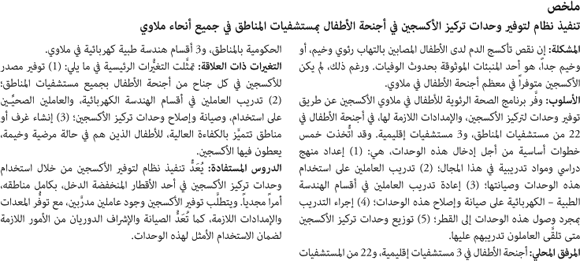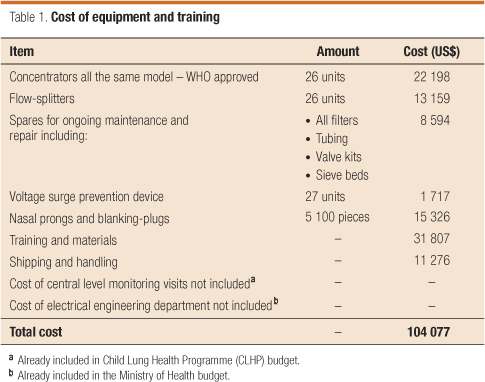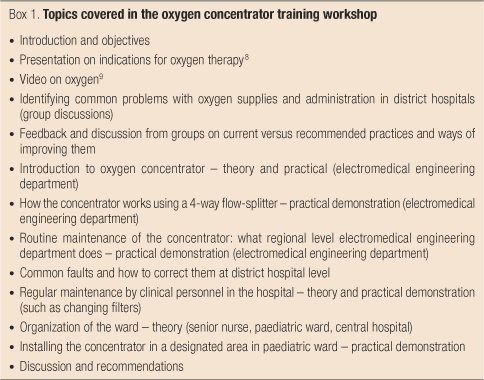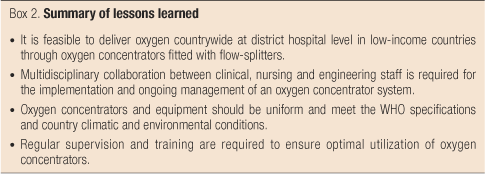LESSONS FROM THE FIELD
Implementation of an oxygen concentrator system in district hospital paediatric wards throughout Malawi
Mise en uvre de concentrateurs d'oxygène dans des services pédiatriques hospitaliers de district à travers le Malawi
Implantación de un sistema de concentradores de oxígeno en salas de pediatría de hospitales de distrito en Malawi
Penny EnarsonI; Sophie La VincenteII; Robert GieIII; Ellubey MagangaIV; Codewell ChokaniV, 1
IChild Lung Health, International Union Against Tuberculosis and Lung Disease, Paris, France
IICentre for International Child Health, Department of Paediatrics, University of Melbourne, Melbourne, Australia
IIIDepartment of Paediatrics and Child Health, Faculty of Medicine, University of Stellenbosch, Tygerberg, South Africa
IVMinistry of Health, Community Health Science Unit, Lilongwe, Malawi
VMinistry of Health, Electromedical Engineering Department, Lilongwe, Malawi
ABSTRACT
PROBLEM: Hypoxaemia in children with severe or very severe pneumonia is a reliable predictor of mortality, yet oxygen was not available in most paediatric wards in Malawi.
APPROACH: The Child Lung Health Programme in Malawi made oxygen available by supplying oxygen concentrators and essential supplies to 22 district and 3 regional hospitals' paediatric wards. Five key steps were taken to introduce concentrators: (1) develop a curriculum and training materials; (2) train staff on use and maintenance; (3) retrain electromedical departments on maintenance and repair; (4) conduct training once concentrators arrived in the country; and (5) distribute concentrators once staff had been trained.
LOCAL SETTING: The paediatric wards in 3 regional and 22 government district hospitals and 3 regional electromedical engineering departments in Malawi.
RELEVANT CHANGES: Main changes were: (1) provision of a source of oxygen in every paediatric ward in all district hospitals; (2) training of electrical engineering and health personnel in the use, maintenance and repair of oxygen concentrators; and (3) setting-up of high-dependency rooms or areas for severely ill children where oxygen is administered.
LESSONS LEARNED: It is feasible to implement an oxygen system using concentrators throughout a low-income country. Oxygen delivery requires trained staff with necessary equipment and supplies. Regular maintenance and supervision are essential to ensure optimal utilization.
RÉSUMÉ
PROBLÉMATIQUE: Chez l'enfant atteint d'une pneumonie très grave ou sévère, l'hypoxémie annonce de manière fiable une évolution mortelle. Pourtant, la plupart des services pédiatriques du Malawi ne disposaient pas d'oxygène.
DÉMARCHE: Le Programme Santé pulmonaire de l'enfant au Malawi a mis l'oxygène à la disposition de 22 services pédiatriques hospitaliers de district et de 3 services pédiatriques d'hôpitaux régionaux, en leur fournissant des concentrateurs d'oxygène et les fournitures indispensables. L'introduction de ces concentrateurs s'est faite en cinq étapes clés : 1) mise au point d'un programme et de supports de formation ; 2) formation du personnel à l'utilisation et à la maintenance de ces appareils ; 3) recyclage des départements d'électronique médicale pour qu'ils puissent effectuer la maintenance et les réparations ; 4) dispensation d'une formation une fois les concentrateurs arrivés dans le pays ; et 5) distribution des concentrateurs une fois le personnel formé.
CONTEXTE LOCAL: Les services pédiatriques de 3 hôpitaux régionaux et de 22 hôpitaux publics de district et 3 départements régionaux de génie électronique médical du Malawi.
MODIFICATIONS PERTINENTES: Les principaux changements ci-après ont été apportés : 1) fourniture d'une source d'oxygène dans chaque service pédiatrique de l'ensemble des hôpitaux de district ; 2) formation du personnel sanitaire et spécialisé en électronique médicale à l'utilisation, à la maintenance et à la réparation des concentrateurs d'oxygène ; et 3) mise en place de salles ou de zones pour patients très dépendants où l'on administre de l'oxygène aux enfants gravement malades.
ENSEIGNEMENTS TIRÉS: La mise en uvre d'un système d'approvisionnement en oxygène utilisant des concentrateurs est faisable dans un pays à faible revenu. La délivrance de l'oxygène nécessite du personnel formé, ainsi des équipements et des fournitures. Une maintenance et une supervision régulières sont essentielles pour garantir une utilisation optimale.
RESUMEN
PROBLEMA: La aparición de hipoxemia en los niños con neumonía grave o muy grave es un factor predictivo fiable de la mortalidad. Pese a ello, la mayoría de las salas de pediatría de Malawi carecían de oxígeno.
ENFOQUE: El Programa de Salud Pulmonar Infantil de Malawi suministró oxígeno facilitando concentradores y suministros esenciales a las salas de pediatría de 22 hospitales de distrito y 3 hospitales regionales. Se tomaron cinco medidas clave para introducir los concentradores: 1) desarrollo de un programa de estudios y de material didáctico; 2) formación del personal sobre su uso y mantenimiento; 3) actualización profesional de los departamentos de electromedicina en materia de mantenimiento y reparación; 4) actividades de capacitación una vez llegados los concentradores al país; y 5) distribución de los concentradores tras haber formado al personal.
CONTEXTO LOCAL: Las salas de pediatría de 3 hospitales regionales y 22 hospitales de distrito públicos, y 3 departamentos regionales de ingeniería en electromedicina de Malawi.
CAMBIOS DESTACABLES: Los cambios principales fueron los siguientes: 1) instalación de una fuente de oxígeno en cada una de las salas de pediatría de todos los hospitales de distrito; 2) capacitación del personal de electroingeniería y salud en el uso, mantenimiento y reparación de los concentradores de oxígeno; y 3) acondicionamiento de habitaciones o zonas reservadas a grandes dependientes para los niños gravemente enfermos, incluida la instalación de sistemas de administración de oxígeno.
ENSEÑANZAS EXTRAÍDAS: Es posible implantar de forma generalizada un sistema de suministro de oxígeno a base de concentradores en los países de ingresos bajos. La administración de oxígeno requiere personal especialmente preparado y dotado del equipo y suministros necesarios, y unas actividades regulares de mantenimiento y supervisión son fundamentales para que se haga un uso óptimo del material.

Background
Hypoxaemia in children with severe or very severe pneumonia is a reliable predictor of mortality, increasing the risk of dying fivefold.1,2 Hospitals throughout the developing world have very limited access to oxygen3 and, when oxygen is available, the equipment required to deliver it is often lacking.4,5 WHO has published technical guidelines for oxygen therapy in the management of childhood pneumonia in low-income countries, covering the indications for use, sources and equipment for the administration of oxygen.6
The Child Lung Health Programme (CLHP) is a collaborative project between the Government of Malawi, the International Union Against Tuberculosis and Lung Disease and the Bill and Melinda Gates Foundation. The CLHP has been incorporated into Malawi's existing health services and implemented by personnel carrying out existing activities for control of acute respiratory infections within the integrated management of childhood illnesses. Policies and procedures, such as oxygen therapy, were coordinated with those in existing programmes.
Specific objectives of the CLHP were: (1) introduction of standard case management for the treatment of pneumonia at district hospital level; (2) improvement of health workers' practice through training and supervision; (3) direction of resources to children most at risk of dying; (4) uninterrupted supply and rational use of antibiotics and oxygen; and (5) generation and use of health services data to improve the quality of service.
In 2000, the International Union Against Tuberculosis and Lung Disease in collaboration with its partner, the Bill and Melinda Gates Foundation, technical experts, Ministry of Health and district health officers evaluated five district hospitals in Malawi to assess the burden of disease of common childhood illnesses. The team observed the functioning of the paediatric ward, pharmacy, radiology and laboratory, reviewed the paediatric outpatient and inpatient registers for the previous 15 months and reviewed the case management of lung disease among hospitalized children. The main causes of morbidity and mortality in hospitalized children aged less than 5 years were malaria, pneumonia, diarrhoea and anaemia.
Problem
During the situation analysis it was found that oxygen was not always available in four out of five district hospital paediatric wards visited. Health workers did not know when or how to administer oxygen to children. Oxygen cylinders were only provided to central hospitals and district hospital operating rooms, as they are expensive and difficult to deliver due to poor roads. Most of the concentrators that were available on the paediatric wards were more than 10 years old and did not meet WHO/United Nations Children's Fund (UNICEF) specifications.7 Where newer WHO/UNICEF-recommended models were available, they did not have flow-splitters, which allow oxygen to be delivered simultaneously to up to four children. Electromedical engineers are responsible for service and repair of oxygen concentrators in all government hospitals but scheduled maintenance visits did not occur, mainly due to a lack of filters and spare parts resulting from financial constraints within the Ministry of Health. Where oxygen was available, nasal prongs and catheters were lacking. Electricity blackouts of 3 hours or more were frequent. In most hospitals the generator and back-up oxygen cylinders were available to operating theatres only.
Approach
Following the situation analysis, the CLHP budget was revised to include oxygen concentrators, appropriate spares and supplies for oxygen delivery, and training of clinical staff and electromedical engineers, which had not been included originally. Therefore it was not possible to include extra funding required to repair and maintain those concentrators not purchased by the CLHP. Costs such as central level monitoring visits and travel allowances were already included within the existing budget. The Ministry of Health already funded vehicle and travel costs and personnel for regular maintenance visits by electromedical engineers, but maintenance did not occur due to lack of the necessary filters and spare parts. The CLHP addressed this problem by funding these supplies (Table 1).

It was decided to supply oxygen concentrators in paediatric wards of all district hospitals, and to develop a package of information and tools to cover all stages from procurement, training, installation and maintenance of oxygen concentrators. This was achieved by undertaking the following steps.
- Identify model/manufacturer of concentrator suitable for Malawi.
- Discuss with manufacturer's engineering department all the components necessary to introduce and maintain concentrators in Malawi.
- Place order based on these recommendations.
- Decide on mode of delivery catheter versus nasal prongs. Calculate amount required and order. It was decided to use nasal prongs based on WHO recommendations6 particularly as these provide the safest method and ease of use and care, which was important due to the high patientnurse ratio.
- Write guidelines for oxygen administration.
- Develop training materials and curriculum.
- Identify appropriate place to install concentrators in paediatric wards.
- Install brackets to secure concentrator to wall so that it cannot be moved to the operating theatre or labour ward.
- Identify and train staff at each hospital on concentrator use and maintenance.
- Visit central and regional electromedical departments and discuss regular maintenance protocol and procedures.
- Identify expert to conduct training once concentrators arrived in country.
- Distribute concentrators to hospitals after training designated staff.
- Lobby for paediatric wards to be included in hospital generator grid and provision of back-up oxygen cylinders.
Training
Prior to the first installation of concentrators in 2002 by CLHP, training workshops were conducted by an electromedical engineer with expertise in maintaining and repairing oxygen concentrators and senior clinical and nursing personnel with expertise in concentrator use and oxygen administration. The first workshop included three electromedical engineers from the three central hospitals who assisted with subsequent training. One anaesthetist (clinical officer) and one senior state-registered nurse working in paediatrics were trained for each of the first five district hospitals implementing the CLHP. Training of general paediatric department staff in oxygen therapy was included in the annual clinical training course held before CLHP implementation in new districts.
The objectives of the workshop were to train electromedical engineers, anaesthetist officers and registered nurses in management and maintenance of concentrators and flow-splitters and in administering and monitoring oxygen therapy. The workshop consisted of technical and clinical presentations,8 a WHO video on oxygen therapy,9 theory and practical sessions on the use, maintenance and repair of the oxygen concentrator and flow-splitters, and hands-on training in the district hospitals (Box 1). Each district hospital received a brochure describing in brief the main points in concentrator use and maintenance,10 a user instruction guide for the model of oxygen concentrators being supplied and a WHO manual on clinical use of oxygen.6 Service manuals for specific oxygen concentrator maintenance were supplied to electromedical engineers.

Relevant changes
The paediatric ward in each district hospital established a separate "high-dependency" room or designated area for severely ill children where the oxygen concentrator was located. The staff were very innovative in setting up these rooms/areas, for example adding hooks for hanging intravenous fluids. Some district hospitals also set up four separate cots to reduce risk of nosocomial infection.
Posters on correct placement and use of nasal prongs and catheters, as well as procedures for administering oxygen, were mounted on the wall. Nasal prongs and filters were issued to each ward before the installation and regularly thereafter.
All district hospitals throughout Malawi now have an oxygen concentrator with flow-splitter on their paediatric ward with trained staff capable of administering oxygen to four children simultaneously.
Monitoring
The introduction of oxygen was only one element of the CLHP, which included the introduction of diagnostic guidelines and clinical staff trained in diagnosis and treatment based upon standard case management. Also included was a system of quality control, logistics to purchase and distribute standardized drugs to ensure uninterrupted supplies, and regular supervision and evaluation of the programme.
Quarterly maintenance visits were scheduled by the electromedical engineers. A logbook was issued with each concentrator to record specific routine preventive maintenance. This record was to be checked during quarterly monitoring visits by CLHP central level staff. Unfortunately many scheduled maintenance visits did not occur due to financial constraints within the electromedical engineering department.
External oxygen review
An external review of the sustainability of oxygen systems using concentrators was conducted in Malawi in June 2007.11 This review identified human resources as a major obstacle, with high staff-turnover rates among nurses and clinical officers, resulting in the need for regular ongoing training of new staff.
Concentrators had been used substantially less than expected, based on the annual number of very severe pneumonia admissions recorded for each hospital.11 In addition to unwillingness among some parents for oxygen therapy, the difficulty in retaining well-trained personnel is likely to have contributed to this apparent underutilization of oxygen. Reliable records of the breakdown and repair of equipment were not available. All hospitals were found to have a functioning oxygen concentrator, thus a prolonged mechanical failure was unlikely to be the primary cause of underutilization.
While electricity failures were reported to be very frequent (daily in most hospitals), 10 out of 15 (67%) paediatric wards that were visited reported that a reliable generator provided the ward with a back-up power source.11
The review found that the difference in performance between the WHO-recommended model purchased by the CLHP and other models purchased by the Ministry of Health varied greatly.11 This highlights the importance of uniformity of equipment and procurement that is appropriate for the environment. Additional details of this review are available from WHO.11
Discussion
The major finding from this process is that it is feasible to deliver oxygen countrywide at district hospital level in low-income countries through oxygen concentrators fitted with flow-splitters (Box 2). The success of such a system depends on: (1) all necessary equipment and supplies being available before installation of concentrators; (2) ongoing regular supply of equipment and supplies; (3) personnel being trained and in place before installation of concentrators; (4) regular maintenance and supervision of system and personnel; (5) use of logbooks to evaluate preventive maintenance; and (6) consideration of climate and environment in selection of equipment and maintenance schedule.

A designated area or room ensures those patients most likely to need oxygen have ready access to the concentrator(s). In Malawi, parents and guardians have been reluctant for their children to receive oxygen therapy, as they believe their child could die once oxygen is administered. Unfortunately, some children arrive at the hospital in a moribund condition and do not survive even when given appropriate care, including oxygen. Pulse oximeters may have assisted in showing parents the positive effects of oxygen therapy. Thus pulse oximetry should also be considered as an important tool to assess patient oxygen needs, instead of relying just on clinical signs.
A challenge for the CLHP is to ensure that routine maintenance occurs and that systems are in place to ensure ongoing distribution of available spare parts. Improved communication between clinical, nursing, engineering and programme administration staff is likely to assist in meeting these challenges. Countries seeking to implement such a programme should ensure that, where high staff turnover is likely to be present, adequate support is available for ongoing training and regular supervision.
The last published data on field-testing and evaluation of oxygen concentrators was over a decade ago, reporting on a trial in Egypt.12 There were no published data found on a similar trial that was conducted in Malawi. The concentrators used in both these trials are no longer produced13 and no similar field experience to test sustainability of new models in developing countries has been reported in the literature since. It is hoped that the information on the introduction and sustainability, over a five-year period, of a newer model of concentrator that is in line with WHO specifications will encourage more countries to introduce a similar programme within paediatric wards for the management of pneumonia. 
Acknowledgements: Sophie La Vincente is undertaking the Master of Applied Epidemiology Program at the National Centre for Epidemiology and Population Health, Australian National University. This programme is funded by the Australian Government's Department of Health and Ageing.
Competing interests: None declared.
References
1. Onyango FE, Steinhoff MC, Wafula EM, Wariua S, Musia J, Kitonyi J. Hypoxaemia in young Kenyan children with acute lower respiratory infection. BMJ 1993;306:612-5. PMID:8369033
2. Lozano JM. Epidemiology of hypoxaemia in children with acute lower respiratory infection. Int J Tuberc Lung Dis 2001;5:496-504. PMID:11409574
3. Nolan T, Angos P, Cunha AJLA, Muhe L, Qazi S, Simoes EAF, et al. Quality of hospital care for seriously ill children in less developed countries. Lancet 2001;357:106-10. PMID:11197397 doi:10.1016/S0140-6736(00)03542-X
4. Wandi F, Peel D, Duke T. Hypoxaemia among children in rural hospitals in Papua New Guinea: epidemiology and resource availability a study to support a national oxygen program. Ann Trop Paediatr 2006;26:277-84. PMID:17132292 doi:10.1179/146532806X152791
5. English M, Esamai F, Wasunna A, Were F, Ogutu B, Wamae A, et al. Assessment of inpatient paediatric care in first referral level hospitals in 13 districts in Kenya. Lancet 2004;363:1948-53. PMID:15194254 doi:10.1016/S0140-6736(04)16408-8
6. Oxygen therapy in the management of a child with an acute respiratory infection. Geneva: WHO; 1995 (WHO/CAR/95.3).
7. Programme for the control of acute respiratory infections: oxygen therapy for acute respiratory infection in young children in developing countries. Geneva: WHO; 1993.
8. Indications for oxygen therapy [presentation]. International Union Against Tuberculosis and Lung Disease. Available from: http://www.iuatld.org [accessed on 20 March 2008] .
9. Oxygen [video]. Geneva: WHO; 2003.
10. International Union Against Tuberculosis and Lung Disease [Association Federative Nationale pour le Traitement A Domicile de L'Insuffisance Respiratoire Chronique]. Oxygen therapy with an oxygen concentrator for acute respiratory infections in young children in emergent countries. Available from: http://www.iuatld.org [accessed on 14 April 2008] .
11. Report on the evaluation of oxygen systems for the hospital care of children in Malawi. Geneva: WHO; 2007 (WHO/FCH/CAH/07.03).
12. Dobson M, Peel D, Khallaf N. Field trial of oxygen concentrators in upper Egypt. Lancet 1996;347:1597-9. PMID:8667871 doi:10.1016/S0140-6736(96)91080-6
13. Report on the informal consultation on clinical use of oxygen. Geneva: WHO; 2003 (WHO/FCH/CAH/04.12).
(Submitted: 26 September 2007 Revised version received: 20 February 2008 Accepted: 27 February 2008)
1 Correspondence to Penny Enarson (e-mail: penarson@iuatld.org).
doi:10.2471/BLT.07.048017
